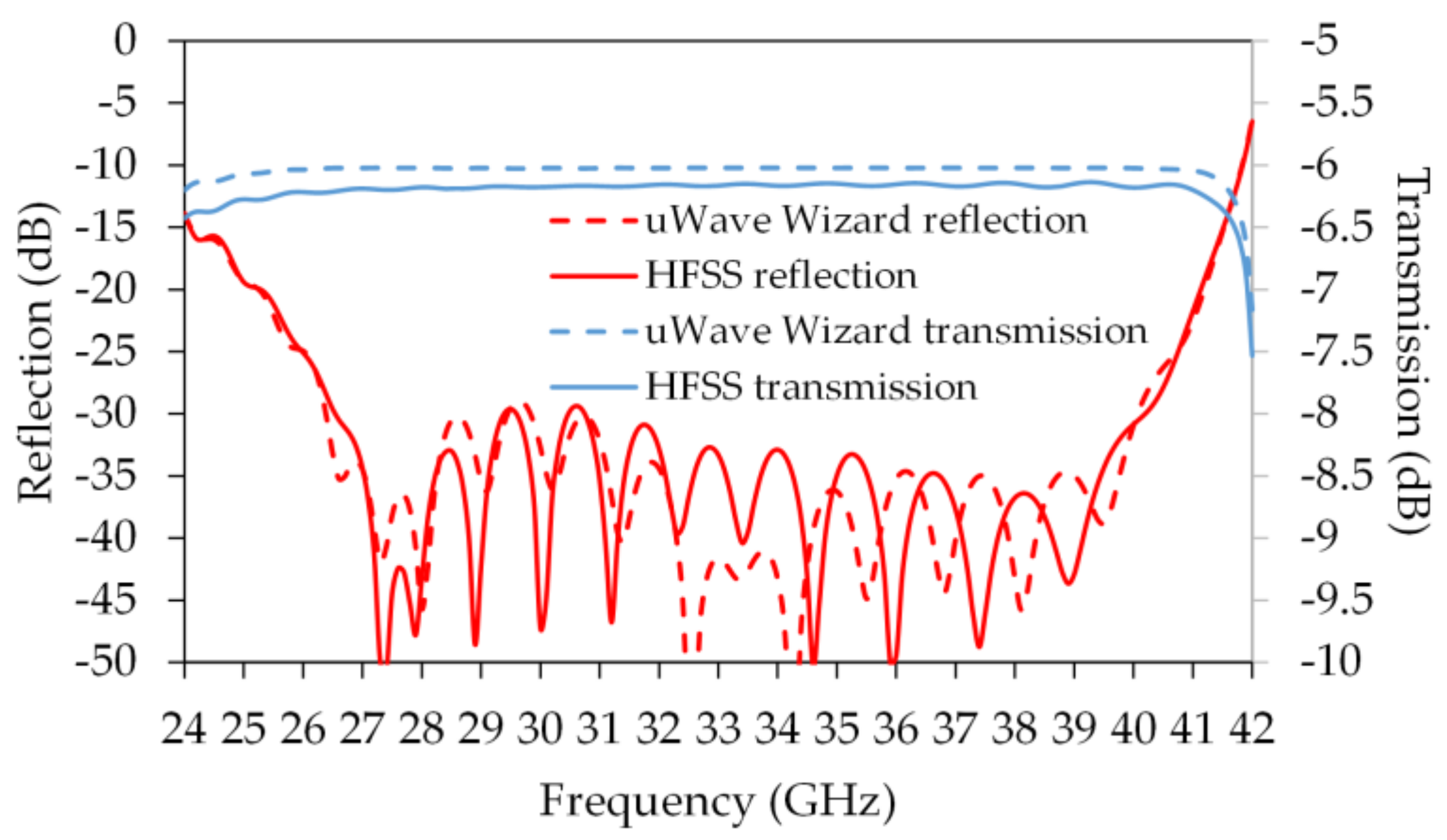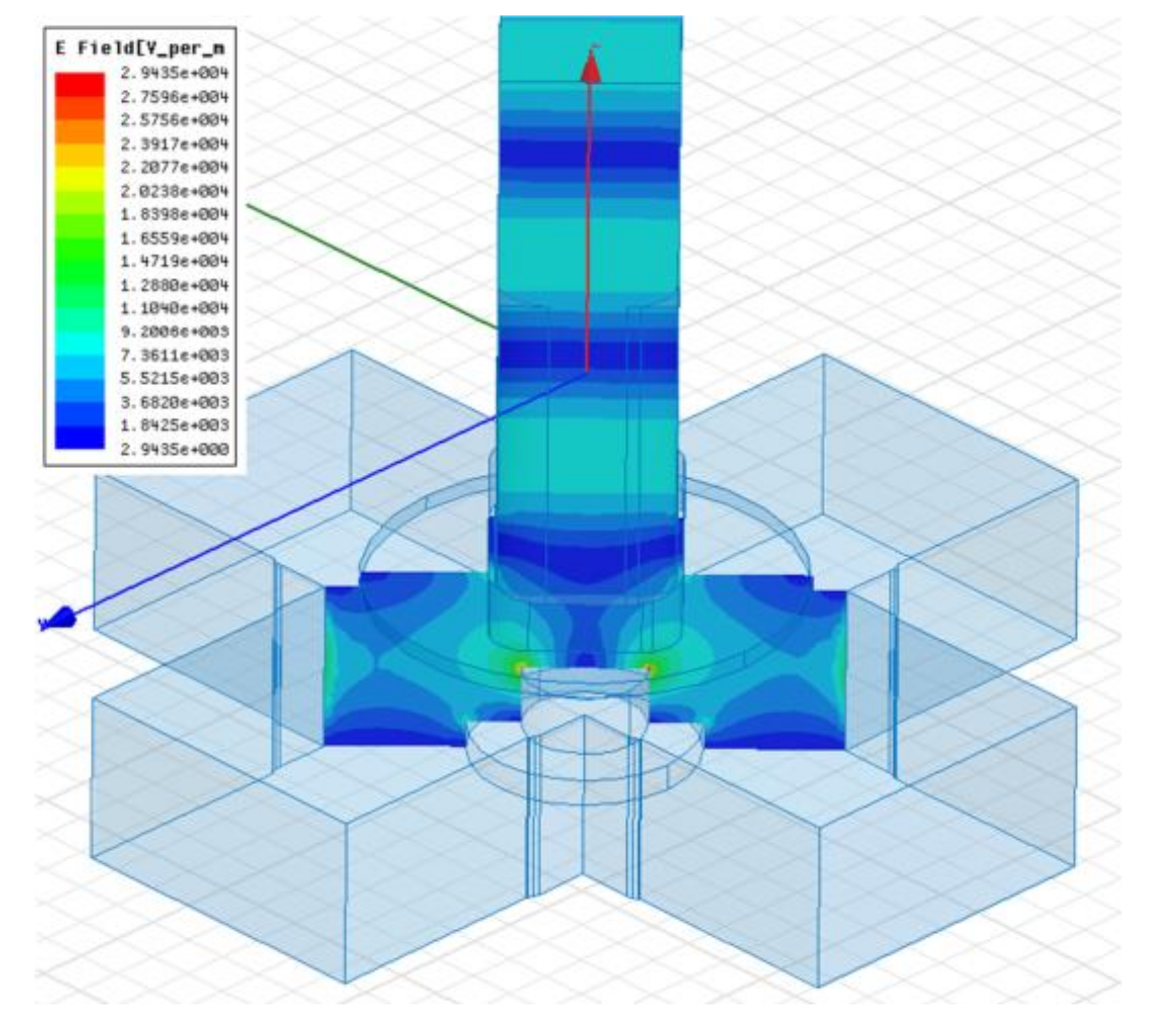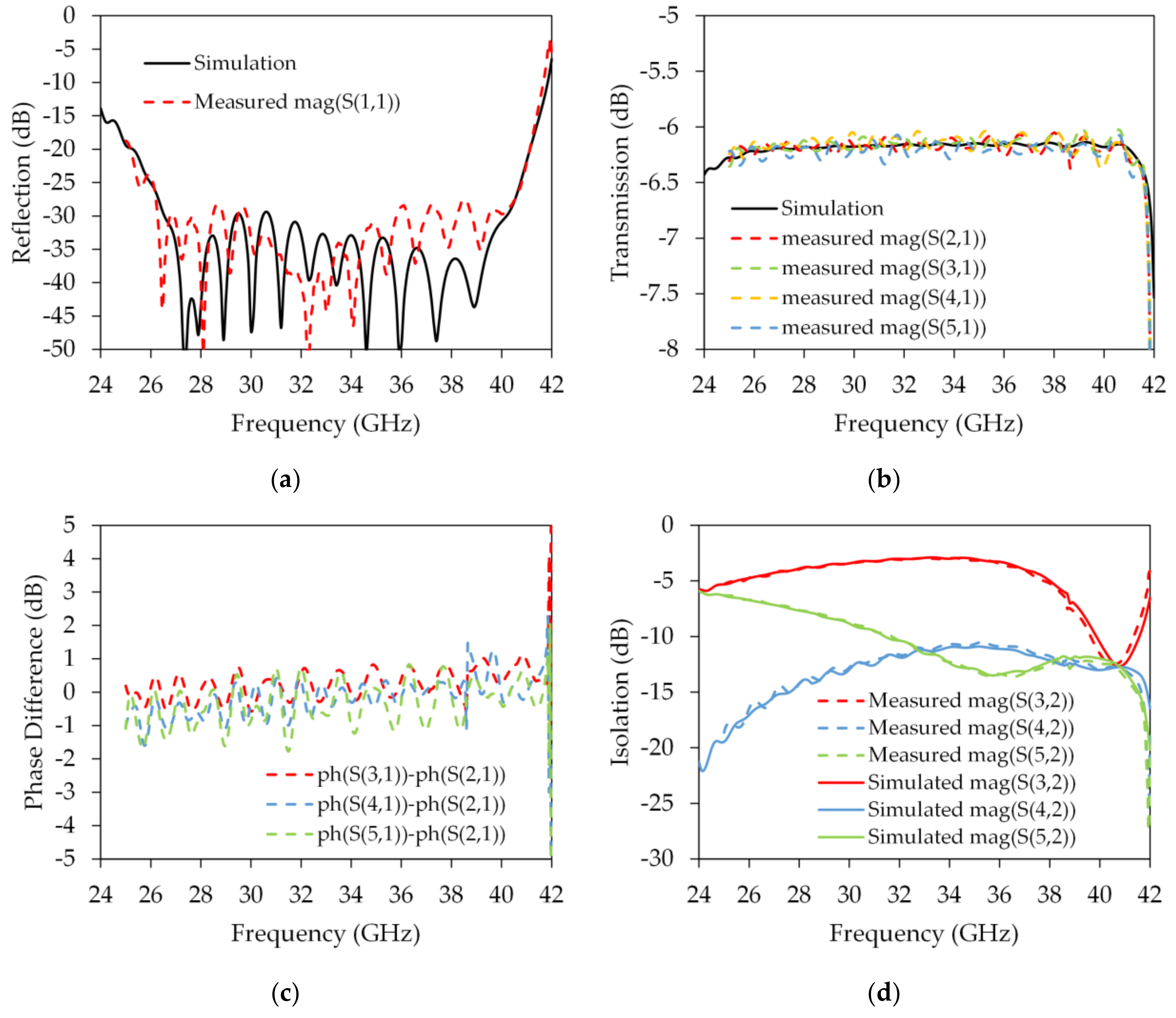Full-Band Oversized Turnstile-Based Waveguide Four-Way Power Divider/Combiner for High-Power Applications
Abstract
:1. Introduction
2. Power Divider/Combiner Design
2.1. The Junction
2.2. E-Plane Bend
2.3. Full Structure Simulation
3. Power Handling Capability Estimation
4. Power Divider/Combiner Characterization and Results
5. Conclusions
Author Contributions
Funding
Conflicts of Interest
References
- Moron, J.; Leblanc, R.; Lecourt, F.; Frijlink, P. 12W, 30% PAE, 40 GHz power amplifier MMIC using a commercially available GaN/Si process. In Proceedings of the 2018 IEEE/MTT-S International Microwave Symposium-IMS, Philadelphia, PA, USA, 10–15 June 2018; pp. 1457–1460. [Google Scholar]
- Yamaguchi, Y.; Kamioka, J.; Hangai, M.; Shinjo, S.; Yamanaka, K. A CW 20W Ka-band GaN high power MMIC amplifier with a gate pitch designed by using one-finger large signal models. In Proceedings of the 2017 IEEE Compound Semiconductor Integrated Circuit Symposium (CSICS), Miami, FL, USA, 22–25 October 2017; pp. 1–4. [Google Scholar]
- Gasmi, A.; Kaamouchi, M.E.; Poulain, J.; Wroblewski, B.; Lecourt, F.; Dagher, G.; Frijlink, P.; Leblanc, R. 10W power amplifier and 3W transmit/receive module with 3 dB NF in Ka band using a 100nm GaN/Si process. In Proceedings of the 2017 IEEE Compound Semiconductor Integrated Circuit Symposium (CSICS), Miami, FL, USA, 22–25 October 2017; pp. 1–4. [Google Scholar]
- Ng, C.Y.; Takagi, K.; Senju, T.; Matsushita, K.; Sakurai, H.; Onodera, K.; Nakanishi, S.; Kuroda, K.; Soejima, T. A 20-watt Ka-band GaN high power amplifier MMIC. In Proceedings of the 2014 44th European Microwave Conference, Rome, Italy, 6–9 October 2014; pp. 1348–1351. [Google Scholar]
- Yin, Z.; Shao, Z.; Liu, L.; Zhu, X. Design of a Novel Broadband Power Divider Based on Oversized-Coaxial and Radial Waveguide. In Proceedings of the 2011 International Conference on Computational Problem-Solving (ICCP), Chengdu, China, 21–23 October 2011. [Google Scholar]
- Ning, Y.; Sun, J.; Liu, J.; Jiang, W. A New Spatial Power Combiner Based on 32-way Ridged Waveguides. In Proceedings of the XXXIth URSI General Assembly and Scientific Symposium (URSI GASS), Beijing, China, 16–23 August 2014. [Google Scholar]
- Kazemi, R.; Hegazi, G.; Fathy, A.E. X-band All-Waveguide Radial Combiner for High Power Applications. In Proceedings of the 2015 IEEE MTT-S International Microwave Symposium, Phoenix, AZ, USA, 17–22 May 2015. [Google Scholar]
- Jia, P.; Chen, L.-Y.; Alexanian, A.; York, R.A. Multioctave Spatial Power Combining in Oversized Coaxial Waveguide. IEEE Trans. Microw. Theory Techn. 2002, 50, 1355–1360. [Google Scholar]
- Song, K.; Xue, Q. Planar Probe Coaxial-Waveguide Power Combiner/Divider. IEEE Trans. Microw. Theory Techn. 2009, 57, 2761–2767. [Google Scholar] [CrossRef]
- Abdolahi, M.; Sabahi, M.M.; Pourgholamhossein, Z.; Sadeghi, H.M. Broadband Eight-way Coaxial Waveguide High Power Combiner/Divider. In Proceedings of the 2017 Progress In Electromagnetics Research Symposium-Spring (PIERS), St. Petersburg, Russia, 22–25 May 2017. [Google Scholar]
- Leggieri, A.; Passi, D.; Di Paolo, F. The Squarax Amplifier: An Electromagnetic and Thermo-Mechanical Innovation. In Proceedings of the Progress In Electromagnetics Research Symposium (PIERS), Guangzhou, China, 25–28 August 2014; pp. 2273–2280. [Google Scholar]
- Leggieri, A.; Passi, D.; Di Paolo, F.; Orengo, G. The Squarax Spatial Power Combiner. Prog. Electromagn. Res. C 2013, 45, 43–55. [Google Scholar] [CrossRef]
- Coaxial Connector Average Power Handling Graph. Available online: http://mpd.southwestmicrowave.com (accessed on 22 January 2019).
- Cheng, N.-S.; Alexanian, A.; Case, M.G.; York, R.A. 20 Watt Spatial Power Combiner in Waveguide. In Proceedings of the 1998 IEEE MTT-S International Microwave Symposium Digest, Baltimore, MD, USA, 7–12 June 1998. [Google Scholar]
- Leggieri, A.; Passi, D.; Di Paolo, F.; Saggio, G. Global Design of a Waveguide X-Band Power Amplifier. Int. J. Simul. Syst. Sci. Technol. 2014, 15, 68–74. [Google Scholar]
- Jiang, X.; Ortiz, S.C.; Mortazawi, A. A Ka-Band Power Amplifier Based on the Traveling-Wave Power-Dividing/Combining Slotted-Waveguide Circuit. IEEE Trans. Microw. Theory Techn. 2004, 52, 633–639. [Google Scholar] [CrossRef]
- Kang, Z.-Y.; Chu, Q.-X.; Wu, Q.-S. A Ka-Band Broadband Traveling-Wave Power Divider/Combiner Based on Low-Loss Septum Unsymmetrical E-plane T-junction Series. In Proceedings of the 2012 IEEE/MTT-S International Microwave Symposium Digest, Montreal, QC, Canada, 17–22 June 2012. [Google Scholar]
- Kang, Z.; Chu, Q.; Wu, Q. A Compact Ka-Band Broadband Waveguide-Based Traveling-Wave Spatial Power Combiner with Low Loss Symmetric Coupling Structure. Prog. Electromagn. Res. Lett. 2013, 36, 181–190. [Google Scholar] [CrossRef]
- Garcia, J.A.; Kosmopoulos, S.; Goussetis, G. A Compact 12-way Slotted Waveguide Power Combiner for Ka-Band Applications. IEEE Microw. Wireless Comp. Lett. 2017, 27, 135–137. [Google Scholar] [CrossRef]
- Epp, L.W.; Hoppe, D.J.; Khan, A.R.; Stride, S.L. A High-Power Ka-Band (31-36 Ghz) Solid-State Amplifier Based on Low-Loss Corporate Waveguide Combining. IEEE Trans. Microw. Theory Techn. 2008, 56, 1899–1908. [Google Scholar] [CrossRef]
- Zang, F.; Song, K.; Li, G.; Zhao, M. Sub-THz Four-Way Waveguide Power Combiner with Low Insertion Loss. J. Infrared Milli. Terahz. Waves 2014, 35, 451–457. [Google Scholar] [CrossRef]
- Bo, S.; Bin, L.; Weng, L.S.; Wenjiang, W. Millimeterwave Eight-way Waveguide Combiner for High Power Combining. In Proceedings of the 2016 IEEE Region 10 Conference (TENCON), Singapore, 22–25 November 2016. [Google Scholar]
- Deng, J.; Wang, Q.; Zhao, P.; Tian, M.; Li, Q. A Quasi-Planar H-Plane Waveguide Power Divider with Full Bandwidth. IEEE Microw. Wireless Comp. Lett. 2018, 28, 645–647. [Google Scholar] [CrossRef]
- Eisenhart, R.L.; Nevils, N.W.; Gulick, J.J.; Monzello, R.C. A Matched Turnstile Type 4-way Divider/Combiner. In Proceedings of the 1983 IEEE MTT-S International Microwave Symposium Digest, Boston, MA, USA, 31 May–3 June 1983; pp. 166–168. [Google Scholar]
- Grubinger, H.; Barth, H.; Vahldieck, R.A. Low-Loss, Wideband Combiner for Power Amplification at Ka-Band Frequencies. In Proceedings of the 2008 IEEE MTT-S International Microwave Symposium Digest, Atlanta, CA, USA, 15–20 June 2008. [Google Scholar]
- Wang, M.; Xie, X.; Zhao, X.; Zhou, L. A Compact Four-Way Power Combiner/Divider in W-Band. In Proceedings of the 2013 Cross Strait Quad-Regional Radio Science and Wireless Technology Conference, Chengdu, China, 21–25 July 2013; pp. 47–50. [Google Scholar]
- Zhang, F.; Song, K.; Fan, M.; Fan, Y. All-Metal-Waveguide Power Divider with High Power-Combining Efficiency. J. Infrared Milli. Terahz. Waves 2016, 37, 258–266. [Google Scholar] [CrossRef]
- Passi, D.; Leggieri, A.; Di Paolo, F.; Bartocci, M.; Tafuto, A. Spatial Power Combiner Technology. In Proceedings of the Progress in Electromagnetics Research Symposium (PIERS), Prague, Czech Republic, 6–9 July 2015; pp. 932–938. [Google Scholar]
- Cano, J.L.; Tribak, A.; Hoyland, R.; Mediavilla, A.; Artal, E. Full Band Waveguide Turnstile Junction Orthomode Transducer with Phase Matched Outputs. Int. J. RF Microw. CAE 2010, 20, 333–341. [Google Scholar] [CrossRef]
- Tribak, A.; Cano, J.L.; Mediavilla, A.; Boussouis, M. Octave bandwidth compact turnstile-based orthomode transducer. IEEE Microw. Wireless Comp. Lett. 2010, 20, 539–541. [Google Scholar] [CrossRef]
- Navarrini, A.; Plambeck, R.L. A Turnstile Junction Waveguide Orthomode Transducer. IEEE Trans. Microw. Theory and Techn. 2006, 54, 272–277. [Google Scholar] [CrossRef]
- Passi, D.; Leggieri, A.; Di Paolo, F.; Bartocci, M.; Tafuto, A. Design of High Power Density Amplifiers: Application to Ka Band. J. Infrared Milli. Terahz. Waves 2017, 38, 1252–1263. [Google Scholar] [CrossRef]
- OMMIC Foundry Webpage. Available online: www.ommic.fr/site/company-1 (accessed on 22 January 2019).
- UMS Foundry Webpage. Available online: www.ums-gaas.com/tag/gan/ (accessed on 22 January 2019).
- QORVO Foundry Webpage. Available online: www.qorvo.com/gan (accessed on 22 January 2019).
- Northrop Grumman Foundry Webpage. Available online: www.northropgrumman.com/BusinessVentures/Microelectronics/Pages/GaNSharedRun.aspx (accessed on 22 January 2019).
- Rosker, M.J. Recent Advances in GaN-on-SiC HEMT Reliability and Microwave Performance within the DARPA WBGS-RF Program. In Proceedings of the 2007 IEEE Compound Semiconductor Integrated Circuits Symposium, Portland, OR, USA, 14–17 October 2007; pp. 1–4. [Google Scholar]
- Lidow, A.; Strittmatter, R.; Zhou, C.; Yanping, M. Enhancement mode gallium nitride transistor reliability. In Proceedings of the 2015 IEEE International Reliability Physics Symposium, Monterey, CA, USA, 19–23 April 2015; pp. 2–2. [Google Scholar]
- Zanoni, E.; Meneghesso, G.; Meneghini, M.; Stocco, A.; Dalcanale, S.; Rampazzo, F.; De Santi, C.; Rossetto, I. Reliability of Gallium Nitride microwave transistors. In Proceedings of the 2016 21st International Conference on Microwave, Radar and Wireless Communications (MIKON), Krakow, Poland, 9–11 May 2016; pp. 1–6. [Google Scholar]
- Zhao, X.; Xu, R.; Xu, Y. An improved nonlinear thermal resistance extraction method for AlGaN/GaN HEMTs. In Proceedings of the 2015 IEEE International Conference on Communication Problem-Solving (ICCP), Guilin, China, 16–18 October 2015; pp. 261–263. [Google Scholar]












| Parameter | Value (mm) | Parameter | Value (mm) |
|---|---|---|---|
| a | 7.1 | l0 | 6.64 |
| b | 3.56 | acav | 7.26 |
| arec | 6.35 | lcav | 1.23 |
| brec | 3.84 | d1 | 4.67 |
| lrec | 1.25 | h1 | 0.56 |
| dcir | 8.92 | d2 | 2.50 |
| lcir | 0.33 | h2 | 1.22 |
| Parameter | Value (mm) | Parameter | Value (mm) |
|---|---|---|---|
| s1 | 0.47 | h2 | 2.22 |
| s2 | 2 | h3 | 0.76 |
| s3 | 2.69 | l1 | 10 |
| h1 | 2.87 | Rtool | 0.6 |
| Reference | Bandwidth (GHz) | Return Loss (dB) | Insertion Loss (dB) | Power Capability (kW) |
|---|---|---|---|---|
| [25] | ~31–38 (20%) | 20 | ~0.1 | - |
| [26] | 85–100 (16%) | 22 (simulated) | 0.04 (simulated) | - |
| [27] | 82–107 (26%) | 14.5 | 0.5 | 6.8 (theoretically) |
| This work | 26.5–40 (40%) | 30 | 0.18 | 10.3 (theoretically) |
© 2019 by the authors. Licensee MDPI, Basel, Switzerland. This article is an open access article distributed under the terms and conditions of the Creative Commons Attribution (CC BY) license (http://creativecommons.org/licenses/by/4.0/).
Share and Cite
Cano, J.L.; Di Paolo, F.; Mediavilla, A.; Colantonio, P. Full-Band Oversized Turnstile-Based Waveguide Four-Way Power Divider/Combiner for High-Power Applications. Electronics 2019, 8, 193. https://doi.org/10.3390/electronics8020193
Cano JL, Di Paolo F, Mediavilla A, Colantonio P. Full-Band Oversized Turnstile-Based Waveguide Four-Way Power Divider/Combiner for High-Power Applications. Electronics. 2019; 8(2):193. https://doi.org/10.3390/electronics8020193
Chicago/Turabian StyleCano, Juan Luis, Franco Di Paolo, Angel Mediavilla, and Paolo Colantonio. 2019. "Full-Band Oversized Turnstile-Based Waveguide Four-Way Power Divider/Combiner for High-Power Applications" Electronics 8, no. 2: 193. https://doi.org/10.3390/electronics8020193








